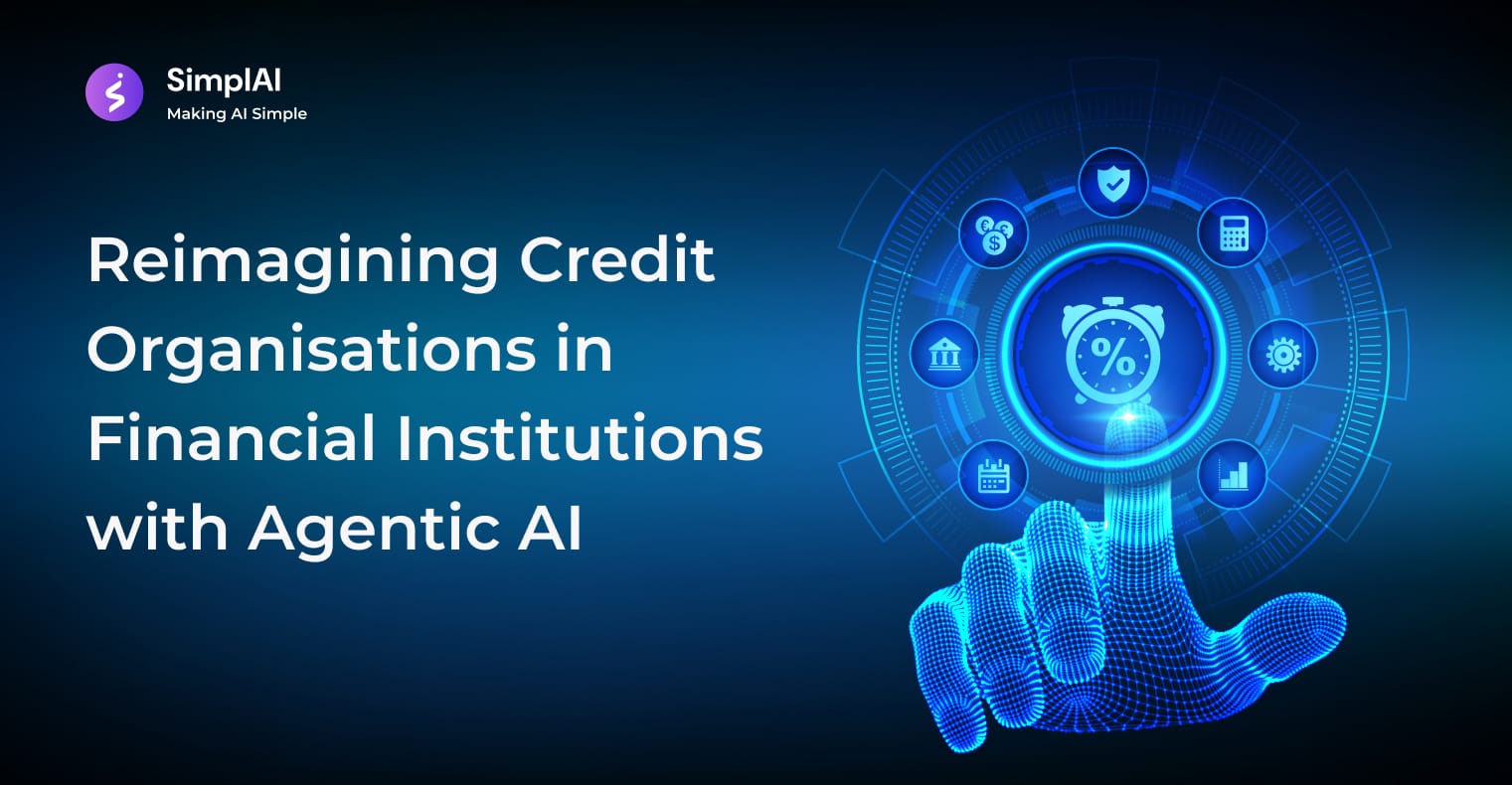Reimagining Credit Organisations in Financial Institutions with Agentic AI

Credit organisations within financial institutions are integral units that assess, manage, and distribute credit to individuals and businesses. These organizations traditionally relied on conventional methods, such as manual underwriting, rigid scoring models, and human-led decision-making processes. While these systems provided structure, they were often plagued by inefficiencies, limited scalability, and a lack of personalisation in risk assessment and customer engagement.
Before the advent of generative AI (GenAI), credit operations were typically linear and siloed. Processes like loan approvals, credit risk modeling, and customer underwriting depended heavily on legacy systems, requiring significant time and effort to gather, process, and analyse data. This approach was resource-intensive and left little room for agility or innovation.
The Multi-Agentic AI Approach: A Paradigm Shift
The integration of Agentic AI and multi-agent systems is revolutionising the way credit organisations operate. By leveraging AI-driven automation, predictive analytics, and generative AI, financial institutions can optimise complex workflows, enhance risk management, and deliver highly personalised customer experiences. For instance, AI-powered multi-agent systems streamline the underwriting process, combining structured and unstructured data to enable faster, more accurate decision-making.
A successful AI transformation in credit organisations demands more than isolated experimentation. Banks must embed AI into their strategic vision, reimagining entire subdomains, such as credit operations, to unlock substantial financial outcomes. Prioritising high-impact areas, such as customer onboarding and risk modeling, allows institutions to drive 70–80% of incremental value.
Traditional Operations of Credit Organisations
Before delving into Agentic AI, it is essential to understand the conventional methodologies used by credit organisations. These practices, while foundational, often lack the agility required to meet modern-day financial demands.
1. Manual Credit Assessments
Traditionally, credit evaluations are based on credit scores, financial statements, and personal interviews. These assessments are carried out by human analysts who:
- Collect and scrutinise borrower information.
- Cross-reference credit histories with financial institutions.
- Use static models to predict risk.
While effective to a degree, this approach is time-consuming and prone to human errors and biases. The reliance on static metrics also limits the flexibility of these assessments.
2. Standardised Risk Management
Risk management in traditional setups revolves around generalised models. These models—often created using historical data—predict default probabilities and determine credit exposure. However, these models can quickly become outdated in dynamic markets, leading to suboptimal decisions.
3. In-Person Customer Interactions
Loan applications and credit-related processes are frequently managed through in-person meetings or extensive paperwork. While this approach allows for human touchpoints, it limits scalability and efficiency.
The reliance on manual processes and static systems has created bottlenecks in operations, prompting a demand for more agile and scalable solutions.

The Advent of Generative AI in Credit Organisations
Generative AI has emerged as a key disruptor, introducing enhanced efficiencies and new possibilities for the credit sector. It builds on conventional AI by creating dynamic, data-driven solutions for real-time applications.
1. Automated Data Analysis
GenAI systems can analyse vast datasets in seconds, identifying complex patterns that human analysts often miss. This allows organisations to:
- Evaluate risk more precisely.
- Recognise potential fraud.
- Offer dynamic, data-backed insights.
2. Enhanced Risk Modeling
Generative AI enables the creation of highly adaptive risk models. These models can:
- Continuously update based on real-time data.
- Account for shifting market conditions.
- Minimise inaccuracies and unforeseen risks.
3. AI-Powered Customer Engagement
One of the most visible applications of GenAI is in customer interaction. AI-driven chatbots and virtual assistants have revolutionised communication, providing personalised assistance to customers. By answering queries instantly, these tools enhance the overall customer experience and reduce operational workloads.
While GenAI has brought notable improvements, it operates within defined parameters and lacks true autonomy. This limitation is addressed by Agentic AI.

Optimising Credit Organisations with Agentic AI
Agentic AI represents the next evolution in artificial intelligence. Unlike traditional AI, Agentic AI systems demonstrate autonomous, goal-directed behaviour, adapting to new information and making independent decisions. Here’s how it can revolutionise credit organisations:
1. Autonomous Decision-Making
Agentic AI systems are capable of assessing credit applications independently. They use advanced algorithms to:
- Evaluate borrower profiles in real-time.
- Make decisions without human intervention.
- Reduce processing times from days to mere minutes.
This autonomy minimises human error and ensures consistent, unbiased evaluations.
2. Dynamic Risk Assessment
Traditional risk models often rely on static data, whereas Agentic AI employs continuous monitoring. It:
- Tracks borrower behaviour and financial trends.
- Adjusts risk models in real-time to reflect current conditions.
- Mitigates potential risks before they materialise.
3. Personalised Customer Solutions
Agentic AI tailors credit products to individual customer needs by autonomously analysing their financial data. This results in:
- Customised loan terms.
- Flexible repayment plans.
- Improved customer satisfaction.

Comparing Conventional Methods and Agentic AI Approaches
A comparative analysis highlights the transformative potential of Agentic AI:
| Aspect | Conventional Methods | Agentic AI Approach |
|---|---|---|
| Processing Speed | Manual evaluations causing delays. | Autonomous assessments enabling instant decision-making. |
| Accuracy | Susceptible to human error and bias. | Data-driven evaluations with enhanced precision. |
| Scalability | Limited by manual processes. | Scalable through automation and intelligent workflows. |
| Customer Experience | Standardized, impersonal service. | Highly personalized, customer-centric solutions. |
Agentic AI overcomes the limitations of traditional credit systems, making organisations more agile and customer-focused.
Implementing Agentic AI with SimplAI
The transition to Agentic AI is made seamless with SimplAI. SimplAI provides robust tools to integrate AI into existing financial workflows.
1. Agentic Workflows
SimplAI’s automation capabilities streamline complex processes, enhancing efficiency. Examples include:
- Automating credit application approvals.
- Dynamic adjustments in loan terms based on borrower behaviour.
2. AI Teammates
SimplAI’s AI teammates collaborate with human staff, offering:
- Real-time insights for decision-making.
- Enhanced accuracy in credit evaluations.
3. Multi-Agent Systems
SimplAI enables organisations to deploy multi-agent systems that work in tandem to:
- Handle multiple aspects of credit operations autonomously.
- Coordinate seamlessly for end-to-end process optimisation.
With SimplAI, financial institutions can harness the full potential of Agentic AI while overcoming challenges like integration and scalability.
Key Benefits of Agentic AI in Credit Organisations
To summarise, the adoption of Agentic AI offers numerous benefits:
- Efficiency: Streamlined operations and reduced processing times.
- Accuracy: Improved decision-making with minimal errors.
- Scalability: Capability to handle increasing workloads without additional resources.
- Customer Focus: Enhanced personalisation leading to higher satisfaction.
These advantages position Agentic AI as a game-changer in the financial industry.
Conclusion
The implementation of a robust AI capability stack ensures scalability, while cross-functional teams and centralised AI governance help maintain alignment across the enterprise. With these strategies, credit organisations can shift from reactive operations to proactive, data-driven ecosystems that drive innovation, efficiency, and profitability.
By embracing this multi-agentic approach, credit organisations are positioned to thrive in an increasingly competitive and technology-driven financial landscape.
The integration of Agentic AI into credit organisations signifies a paradigm shift from manual, traditional processes to autonomous, efficient, and customer-oriented operations. By embracing this technology, financial institutions can enhance accuracy, eliminate biases, and deliver unparalleled customer experiences. Platforms like SimplAI play a pivotal role in this transition, providing the tools necessary for a seamless integration of Agentic AI. As the financial industry continues to evolve, adopting Agentic AI is no longer a luxury but a necessity for organizations aiming to stay competitive.
FAQs
1. What is Agentic AI, and how does it differ from conventional AI?
Agentic AI is an advanced form of artificial intelligence that demonstrates autonomous, goal-directed behaviour. Unlike conventional AI, which relies on predefined rules, Agentic AI adapts to new information and makes independent decisions in real time.
2. How can Agentic AI enhance credit risk assessment?
Agentic AI autonomously analyses vast amounts of financial data, identifying nuanced patterns that traditional methods may overlook. This results in more accurate and timely credit risk evaluations.
3. What role does SimplAI play in adopting Agentic AI?
SimplAI provides a platform that simplifies the integration of Agentic AI into financial workflows. It offers features like agentic workflows, AI teammates, and multi-agent systems to automate and optimise credit operations.
4. What are the challenges of transitioning to Agentic AI?
Transitioning to Agentic AI can involve challenges like integrating with legacy systems, ensuring data security, and training staff. However, platforms like SimplAI offer solutions to address these hurdles effectively.
5. Why is Agentic AI considered a game-changer for credit organisations?
Agentic AI revolutionises credit organisations by enabling autonomous decision-making, dynamic risk assessments, and personalised customer solutions, thereby enhancing efficiency, accuracy, and customer satisfaction.

